Jumps and Bumps
From Burgess Explosion to Sixth Extinction

Going, Going, Gone
ELE Extinction Level Events
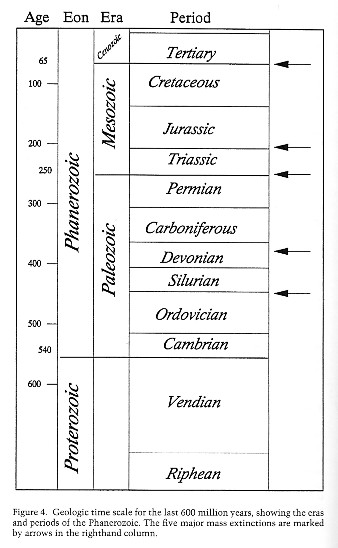
Life is usually stable, but in a 'punctuated equilibrium' (the longtime debate between catastrophism and gradualism/uniformitarianism), with sudden burst of evolutive change (much like paradigm shifts in epistemiology): five 'big' past mass extinctions are identified, defining the end of several life periods, the Ordovician, late Devonian, Permian, Triassic, and Cretaceous; a Sixth, Holocene, human-caused extinction, is underway, making ELE catastrophies, although rare and of low probability, a serious concern.
No catastrophy kills everybody, nor instantaneously. There are always survivors, protected niches, and the process has a progressive component, as the planet and ecosystems are complex/living systems that try to compensate but sometimes fall in a destructive feedback loop.
Below ELE are human CLE, civilization-level events, which directly or indirectly end whole cultures, sometimes only locally, sometimes in extended zones.
Many smaller catastrophies happen, reminding of the relative importance of everything.
How ?
 Mass Extinctions and Their Aftermath, by A. Hallam, P. B. Wignall
Mass Extinctions and Their Aftermath, by A. Hallam, P. B. WignallPerilous Planet Earth: Catastrophes and Catastrophism through the Ages, by Trevor Palmer
Ways To Destroy Life, Palaeofiles
Twenty ways the world could end suddenly, Discover, by Corey Powell
Exit Mundi, End-of-World Scenarios
Doomsday scenarios, Environmental Disasters
Armageddon online
Armageddon in SF movies in 2000, Journal of Religion and Film
Three categories of exogenous events can provoke these mass extinctions: from space (asteroids, radiations), from fluids (climate, concentrations of CO² carbon dioxyde or O²xygen or O³zone or Silicates), from the ground (earthquakes, volcanic eruptions). Over very long geological periods, the probability of such events becomes high, and they determine life's cycles of extinctions and diversifications. Causes are often mixed, interacting in complex quasi-biological ways, and difficult to sequence, e.g. an asteroid strike could disturb the ground into quakes and eruptions and maybe some wegenerian continental drift, and disturbs the waters into megatsunamis and the air into pollution and volcanic 'winter'.
A fourth category is endogenous events within the life forms, as competitions, plagues, pollutions, and resource exhaustions.
Asteroid Impacts
 are a significant but rare factors in the development of life, in wiping out a large proportion periodically, sometimes in showers or clusters. All craters do not remain visible on Earth because of erosion by rain, snow, and wind, of vegetation growth, of ocean cover, whereas on the Moon they remain for eons until a new projectile strikes the scar zone. Many craters are nowadays detected by satellite imaging (high sensitivity), but their correlation with significant earth events often remains uncertain (low specificity), and a causal relation is even more difficult to establish in complex causal sequences or interactions (e.g., an impact triggers tectonic moves and eruptions, CO² ocean acidification, ocean-bottom methane release, provoking a climate shift, causing ecological adaptations).
are a significant but rare factors in the development of life, in wiping out a large proportion periodically, sometimes in showers or clusters. All craters do not remain visible on Earth because of erosion by rain, snow, and wind, of vegetation growth, of ocean cover, whereas on the Moon they remain for eons until a new projectile strikes the scar zone. Many craters are nowadays detected by satellite imaging (high sensitivity), but their correlation with significant earth events often remains uncertain (low specificity), and a causal relation is even more difficult to establish in complex causal sequences or interactions (e.g., an impact triggers tectonic moves and eruptions, CO² ocean acidification, ocean-bottom methane release, provoking a climate shift, causing ecological adaptations).Dis-Asters (Bad Star events) and the 4S (Scarce Star's Scars Scare):
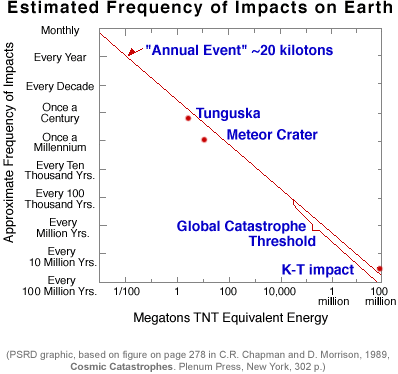
Cosmic impacts, with a possible frequency of roughly once every 100,000 years, also sometimes intervene into the fall of mankind’s ancient civilisations, with stories of ancient apocalypse and hell fire from the sky preserved in mythology and religions, and systematic epistemiological interpretation biases for or against this catastrophism.

 Impact Craters/scars = Astroblemes
Impact Craters/scars = AstroblemesImpact Cratering On Earth
Rogue Asteroids and Doomsday Comets: The Search for the Million Megaton Menace That Threatens Life on Earth, by Duncan Steel, Arthur C. Clarke
Asteroid Threat book list
Earth Meteoritic Impacts, List Of Craters, by Thierry Lombry
The Great Impact Debate, Astrobiology Magazine
 Astronomical reasons explain the relative frequency of this cause of catastrophy: the solar system contains many smaller bodies with an unstable trajectory, and gravity can lead them straight to the planets, which are then protected only by an intruder-burning athmosphere.
Astronomical reasons explain the relative frequency of this cause of catastrophy: the solar system contains many smaller bodies with an unstable trajectory, and gravity can lead them straight to the planets, which are then protected only by an intruder-burning athmosphere.Asteroids, or planetoids, are small space bodies orbiting the inner solar system, with low eccentricity, as planets do. Centaurs (asteroids orbiting between Saturn and Neptune) are named after mythological centaurs, Trojans after heroes from the Trojan War, and trans-Neptunian objects after underworld spirits.

 Comets are bodies from the outer solar system, orbiting the sun on an eccentric, highly elliptical pathway, often with a atmospheric gaseified "hairy" tail when they near the sun.
Comets are bodies from the outer solar system, orbiting the sun on an eccentric, highly elliptical pathway, often with a atmospheric gaseified "hairy" tail when they near the sun.Trans-Neptunians are bodies of the outer solar system, orbiting the sun without much eccentricity, like small distant planets, and rarely entering the inner solar system, where they could reach Earth as meteorites.
Asteroids or comets are also meteorites or "impactors" if they impact the Earth; not all Trans-Neptunian meteorites are typical comets, some look more like eccentric planets. Meteors are small meteorites from the smaller space bodies also called meteoroids.
The rogue space rocks, large meteorites and comets, come from the outer limits of the solar system, the TransNeptunian Objects (TNOs), the Kuyper Belt, the scattered disk, and the Oort cloud.




Some speculated bigger impactors, on the model of the much earlier Moon's formation from a probable giant collision between Earth and its Mars-sized trojan Theia which sent her spinning: supplementary quasi-planets as a 10th Planet X,
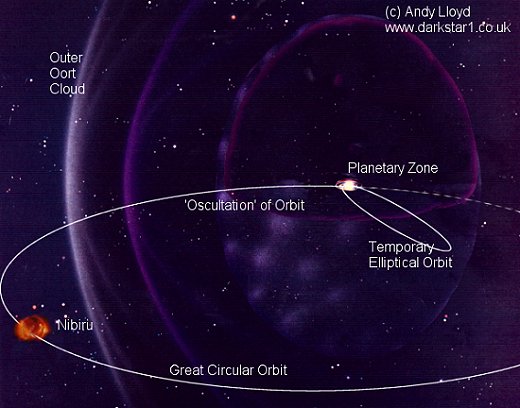 like cubewanos 2003 EL61, 5000 Quaoar, 2005 FY9 Zenn, 20000 Varuna (of Kuyper), 2003 UB313 nicknamed Xena (of the scattered disk), or 90377 Sedna (of Oort) (the definition as a planet is variable under a size, with Pluto just 'downgraded' from 9th planet status in 2006), and even an hypothetical mysterious companion star of the Sun, called Nemesis or Vulcan or Nibiru,
like cubewanos 2003 EL61, 5000 Quaoar, 2005 FY9 Zenn, 20000 Varuna (of Kuyper), 2003 UB313 nicknamed Xena (of the scattered disk), or 90377 Sedna (of Oort) (the definition as a planet is variable under a size, with Pluto just 'downgraded' from 9th planet status in 2006), and even an hypothetical mysterious companion star of the Sun, called Nemesis or Vulcan or Nibiru,Climate Shifts
Gamma-Ray-Bursts and ozone shield malfunction
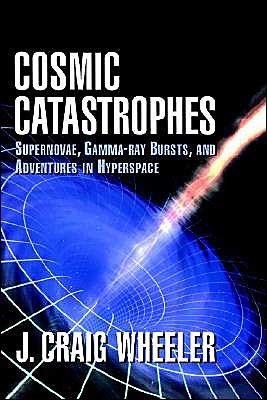 High-energy star catastrophies might trigger ELE.
High-energy star catastrophies might trigger ELE.Life on Earth is protected by the oxygen and ozone (O³) layers, and by the planet's own magnetic rotational field deflecting the sun's field and its particles/rays.
Several starlife events, black hole/supernova explosion, or some neutron star events as a collision, could generate an intense gamma-ray burst (GRB) which could hypothetically destroy ozone and durably leave the way for the sun's own ultraviolet rays to cook out life (Ordovicious extinction hypothesis).
The best understood GRB are produced when a massive star runs out of
 nuclear fuel and the star's core collapses to form a black hole surrounded by a disk of extremely hot, rapidly rotating, magnetized gas. Much of this gas is inexorably swallowed into the black hole, but some is flung away, with intense gamma radiation, worth as much energy in ten seconds as our Sun emits in its entire lifetime, in the most luminous events known in the universe since the Big Bang, escaping from this giant magnet's poles in oppositely directed jets, traveling near/at the speed of light, progressively diverging on their long way.
nuclear fuel and the star's core collapses to form a black hole surrounded by a disk of extremely hot, rapidly rotating, magnetized gas. Much of this gas is inexorably swallowed into the black hole, but some is flung away, with intense gamma radiation, worth as much energy in ten seconds as our Sun emits in its entire lifetime, in the most luminous events known in the universe since the Big Bang, escaping from this giant magnet's poles in oppositely directed jets, traveling near/at the speed of light, progressively diverging on their long way. Although extremely frequent daily in space (1,000 from which only 1 detected), GRB cause ELE even more rarely than matter impacts, as the GRB source has to be near Earth (within a say 500 light-years radius, in our galaxy), and narrowly focused towards it to convey massive energy. Most GRB arrive randomly as insignificant tiny lightspots, having traveled from far outside of our galaxy, likely from the edge of the universe at distances billions of light years away. Recent research associates GRB with metal-poor galaxies (unlike ours), unlikely to host life, making GRB-induced ELEs even more improbable.
Although extremely frequent daily in space (1,000 from which only 1 detected), GRB cause ELE even more rarely than matter impacts, as the GRB source has to be near Earth (within a say 500 light-years radius, in our galaxy), and narrowly focused towards it to convey massive energy. Most GRB arrive randomly as insignificant tiny lightspots, having traveled from far outside of our galaxy, likely from the edge of the universe at distances billions of light years away. Recent research associates GRB with metal-poor galaxies (unlike ours), unlikely to host life, making GRB-induced ELEs even more improbable.Cosmic Catastrophes: Supernovae, Gamma-Ray Bursts, and Adventures in Hyperspace, by J. Craig Wheeler
Gamma-Ray Bursts: Introduction to a Mystery, by NASA
Gamma-Ray Astronomy Team , by NASA
Chandra X-Ray Observatory images
 A fictional variant on light-speed impactor GRBs are the Death-Ray theories, whereby intelligent beings intentionally release a focused energy beam, sometimes on planetal scale as to provoke an ELE . In the SF novel The Killing Star, powerful paranoid aliens even hurl "relativistic bombs" (material impactors at near-light-speed) towards potential competitor civilizations to preventively wipe them out (this would cost gigantic energy in the first place to send massive impactors in such motion).
A fictional variant on light-speed impactor GRBs are the Death-Ray theories, whereby intelligent beings intentionally release a focused energy beam, sometimes on planetal scale as to provoke an ELE . In the SF novel The Killing Star, powerful paranoid aliens even hurl "relativistic bombs" (material impactors at near-light-speed) towards potential competitor civilizations to preventively wipe them out (this would cost gigantic energy in the first place to send massive impactors in such motion).Global Warmings and Global Winters
are triggered by several mechanisms, including athmospheric dispersion of light-blocking debris or selective UV-trapping gases (CO², CH4, O³zone), and then can run away through positive feedbacks, as albedo (ice/water/land reflectivity) variation.
Once the balance of climate and fertility is tipped, it becomes very difficult to redress, explaining the correlation of long-lasting civilizations with religions of respect for nature's equilibrium.
A Green History of the World: The Environment and the Collapse of Great Civilizations, by Clive Ponting
Methane Degassing
A lot of CH4 methane gas, from decomposition of fallen bodies, is trapped underwater and in permafrost, in semi-solid frozen form (chlatrate hydrates).
When Global Warming sets in, this gas gets freed and exacerbates the greenhouse effect in a catastrophic positive feedback loop.
Water concentrations of solubles (carbonates, silicates) can impact life, e.g. through substrates provision, or through acidification.
Ground Events
Wegenerian plate divergence (Pangea into Gondwana and Laurasia) or convergence (North and South Americas) modify darwinian competition and can lead to extinctions
Earthquakes are mainly destructive if their epicenter is undersea and triggers a tsunami.
 Prolonged massive volcanic eruptions (Deccan, Russia), possibly initiated by destabilizing impacts, can cause first a light-filtering global "winter", then a greenhouse gas emission global warming.
Prolonged massive volcanic eruptions (Deccan, Russia), possibly initiated by destabilizing impacts, can cause first a light-filtering global "winter", then a greenhouse gas emission global warming.Supervolcanic caldera (cauldron, the cavity where hot lava and gas accumulate without exit, building up high pressure) explosions (Yellowstone, Toba, Santorin, Krakatau), cause debris dispersion and darkened-sky volcanic "winters". Volcanoes' localization is stable, and eruptions often repeat in the same region (Indonesia, Yellowstone, ...). Their geometrical Volcanic Explosivity Index (VEI = 4 + logarithm -"the number of zeros"- of the expelled volume in km³) reach the scale's maxima of 7 and 8 (corresponding to > 1000 and > 10,000 km³).
A simple calculation shows how even massive caldera explosions of > 10,000 km³ (VEI=8) are dwarfed by impactors: a VEI=8 volume is matched by a 25 km crater (12 km of radius and assuming only a half-height of 6 km), whereas the biggest impact craters reach at least 10 times that size, displace up to 10³=1,000 times more debris volume, 3 more VEI degrees, VEI= 11 (and the Shiva impact of India, with 600 km, could have reached an order of magnitude of VEI= 12). Caldera explosions are "only" CLEs (they almost wiped out humankind around BCE 100,000), while only very long eruptions (by global winter then gas-driven global warming) or/caused by massive impacts (by debris and global winter), are ELEs.
 Landslides (Canarys) and ice slide/release megatsunamis/megafloods (Global Warmings), ocean impacts, and ocean caldera explosions (Indonesia), can cause
Landslides (Canarys) and ice slide/release megatsunamis/megafloods (Global Warmings), ocean impacts, and ocean caldera explosions (Indonesia), can cause  Megatsunamis.
Megatsunamis.Geomagnetic field reversals: have no known consequence
A geomagnetic reversal is a change in the orientation of Earth's magnetic field such that the positions of magnetic north and magnetic south become interchanged. This happens with an uneven periodicity of 200,000 to 1,000,000 years, typically lasts a few hundred to a few thousands years, often involves an extended decline in field
 strength followed by a rapid recovery after the new orientation has been established.
strength followed by a rapid recovery after the new orientation has been established.Some speculate that a greatly diminished magnetic field during a reversal period will expose the surface of the earth to a substantial and potentially damaging increase in cosmic radiation, but without evidence that a magnetic field reversal has ever caused any extinction; a possible explanation is that the solar wind may induce a sufficient magnetic field in the Earth's ionosphere to shield energetic particles even in the absence of the Earth's normal magnetic field.
Nuclear explosions
 Natural nuclear reactions are known to have occured spontaneously on Earth, but only with localized radiation consequences. In human times, military devices or civilian pollution, could contaminate vast portions of land and sea, causing deaths and delayed mutations.
Natural nuclear reactions are known to have occured spontaneously on Earth, but only with localized radiation consequences. In human times, military devices or civilian pollution, could contaminate vast portions of land and sea, causing deaths and delayed mutations.The advent of the human nuclear age and M.A.D. theories, maintains the scare of at least localized destruction and irradiation, with little protection ("Dump, And Cover" ?). The largest H bombs detonated in modern times reach a VEI equivalent in the range of only 4.
The civil use of atomic energy also entails meltdown, contamination, and widespread pollution risks (e.g. Chernobyl; generalization of unsafe nuclear electricity production at the end of the Hydrocarbon Age).
Biological Catastrophies
include genocidal competitions (as the failure of South American marsupials invaded by North American mammals), plagues, pollution and resource exhaustion (as in the man-made Sixth Extinction).
When ?
BCE 15,000,000,000 Universe
BCE 5,000,000,000 Sun
BCE 4,600,000,000 Earth
BCE 4.4 billion Water

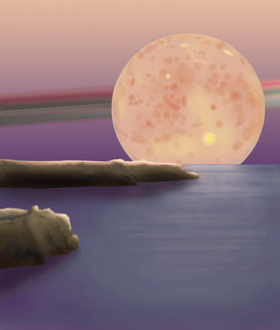
from bombardment Hadean to Early Archean Cool Earth
BCE 4,200,000,000 Life

 Protobiotes need:
Protobiotes need:- organizing mechanisms: open-system nature spontaneously self-organizes, from the physico-chemical level up, through instable transitions, to attractor stabilities (Prigogine), chemically evoluting in rapid leaps (Eldridge & Gould, punctuated equilibrium)
- basic molecules: form in Earth's Archean broil with energy, but also in space (sugar and carbomolecules, amino acids, water, membranes, biomagnetite in ALH 84001, buckminsterfullerenes), with possible transspermia and coevolution with solar planets at least
- energy (heat, geothermal vents, impactors, lightning, geochemical)
- boundary: by concentration or/and container (dessicating pond, self-assembling lipid vesicles, atmospheric droplets), with resistance
- self-replicator catalysis (informational polymers RNA ribozymes, simpler PNA or TNA, DNA Mimivirus; clay crystals theory, other alphabets)
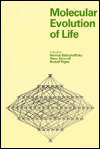 Origin and evolution of life, by David Darling
Origin and evolution of life, by David DarlingEarly Earth, by Stanley Awramik
The Origins and Early Forms of Life, booklist, by Mark Mitch

The Origins of Life, Principia Cybernetica, by F. Heylighen, & C. Joslyn
Composing life, by Daniel Segré & Doron Lancet
BCE 4 to 2.3 billion Archean
BCE 4 billion Protobiotes
BCE 4 billion Virus ?
BCE 4 billon Cells
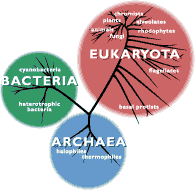
Prokaryotes
BCE 3.8 billion Anaerobic Archeobacteria

Blue-Green Algae pile into Stromatolites
evolute into releasing O²xygen, destroying the greenhouse effect gas methane CH4, causing a first Snowball Earth interval, decimating unicellular life and stimulating the evolution of aerobic (O²xygen-consuming) cells, while the O³zone layer protects life in seas from solar radiation
BCE 2.3 billion to 523 million Precambrian
BCE 2.3 billion Aerobic Bacteria
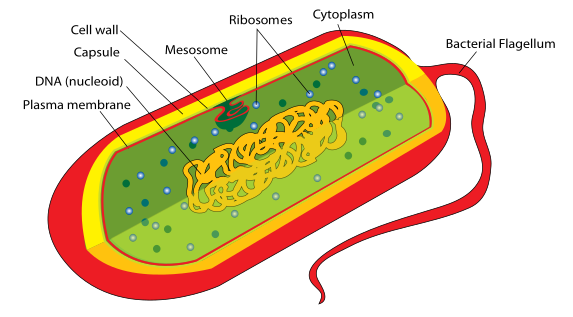 external form (phenotype) is a common adaptation to environment and by very different lifeforms: here a (far bigger) multicellular present larva of a primitive chordate (proto-vertebrate), appeared well before tadpoles
external form (phenotype) is a common adaptation to environment and by very different lifeforms: here a (far bigger) multicellular present larva of a primitive chordate (proto-vertebrate), appeared well before tadpoles
BCE 2,2 billion Eukaryotes
Cells with internal membraned organ(elle)s

Endosymbiosis
is the process wherein one smaller prokaryotic cell lives within the cytoplasm of a larger eukaryotic cell, into a mutually beneficial and stable, symbiotic, relationship. The eukaryotic chloroplasts (organelles for photosynthesis in vegetals) descend from cyanobacteria, the eukaryotic mitochondria (organelles for aerobic respiration) descend from bacteria, and the membraned nucleus might descend from protovirus (such as the giant Mimivirus)


Eukaryotes into Vegetal and Animal (and Fungus)
Euglena, an unicellular with photosynthetic (proto-vegetal) capability
 -->
-->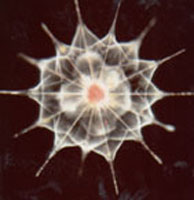
< -- Acantharea, a star-shaped unicellular (protist) without photosynthesis (proto-animal) but with a complex exoskeleton hosting symbiotic algae (vegetals)
BCE 2 billion
 Vredefort, South Africa, 300km
Vredefort, South Africa, 300kmthe second largest (remaining) impact crater on Earth
BCE 1.8 billion
 Sudbury, Canada, 250km
Sudbury, Canada, 250kmBCE 750 million: equatorial Supercontinent Rodinia starts rifting apart

to reassemble around BCE 620 million into a new configuration (under the polar ice cap), Pannotia, then rift apart again around BCE 540 million
BCE 750-600 million: Snowball Earth


Only one limited supercontinental mass (Rodinia) supposedly generates climate instability, with a tendency towards huge climate oscillations, with mass extinctions, in turn favouring later speciation.
At the pole, the supercontinent freezes, reflects light and freezes further in a catastrophic positive feedback loop.
The cycle supposedly ends because volcanoes protrude above the frozen landscape and pump out greenhouse gas carbon dioxide. Without rain to wash this carbon dioxide out of the atmosphere, it concentrates until eventually sparking off corrective global warming and global meltdown.
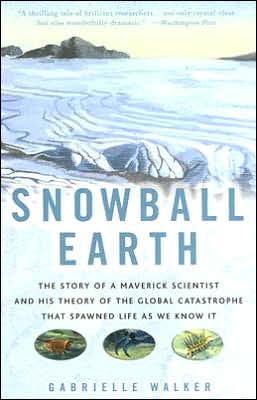 Snowball Earth: The Theory of the Global Catastrophe That Spawned Life As We Know It, by Gabrielle Walker
Snowball Earth: The Theory of the Global Catastrophe That Spawned Life As We Know It, by Gabrielle WalkerSnowball Earth
BBC Science & Nature
Snowball
Several Unicellulars manage to survive this super-glaciation: bacteria and archea associated with deep-sea hydrothermal vents, photosynthetic eukaryote algae, below cracks in the dynamic sea-ice, some amoebae and other protists, and a few colonial unicellulars, ...
Then, with deglaciation,

 Multicellulars
Multicellularstimidly appear (in the record) at the end of the Precambrian, including attempts at trilateral symmetry
BCE 590 million Ediacaran extinction
 Acraman, Australia, 160 km
Acraman, Australia, 160 kmAll these new multicellular micro-organisms are wiped out, and the Ediacaran (or Vendian) fauna might have no living representatives.
A little known, late Precambrian rehearsal of later explosions & extinctions.
BCE 540 million: supercontinent (then Pannotia) rifts apart again

BCE 5,200,000 Multicellulars (Explosion)
end Precambrian --> Paleozoic

BCE 525 million Cambrian Explosion
The body plans of nearly all living multicellular animals appears in a very short interval between 600 and 525 million years ago, a series of global "freeze-fry" events causing population "bottlenecks and flushes", accelerating evolutionary rates.
The crash in population size accompanying a global glaciation is followed by millions of years of comparative genetic isolation in high-stress environments. This is a favorable scenario for genomic reorganization and the evolution of new body plans. Finally, repopulations following each glaciation occurs in transient selective environments quite different from those preceding the glaciation, favoring the emergence of new life forms.
Proto- and Deutero- stomes show life's invention of two simple variant ways to organize a multicellular embryonic ball, making a first aperture either the front end or the rear end
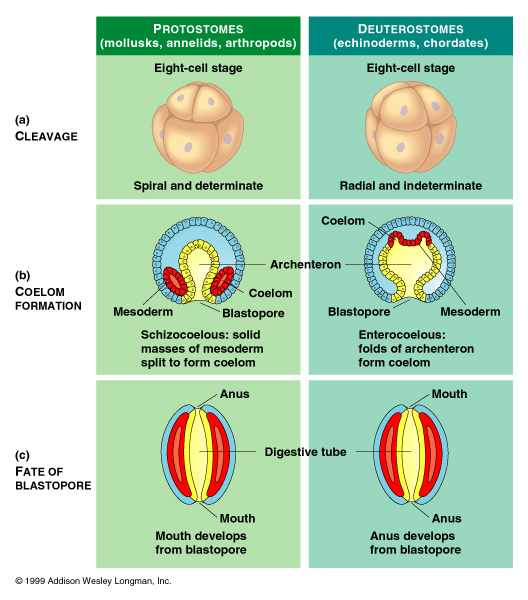
BCE 525 million Maotianshan shale
BCE 505 million Burgess Shale

In just 10-20 million years, an evolutionary "Big-Bang" called the Cambrian Explosion produces a full spectrum of complex oceanic animal forms, 90% of modern diversity, including exosquelettal hard-shelled and endosquelettal chordates (proto-vertebrates):
trilobites Olenoides (1), brachiopods (2), mollusks (3), and crinoids (4), sponges Vauxia (5), Hazelia (6), and Eifellia (7); brachipods Nisusia (2); priapulid worms Ottoia (8); other arthropods Sidneyia (9), Leanchoilia (10), Marella (11), Canadaspis (12), Helmetia (13), Burgessia (14), Tegopelte (15), Naraoia (16), Waptia (17), Sanctacaris (18), and Odaraia (19); lobopods Hallucigenia (20) and Aysheaia (21); mollusks Scenella (3); echinoderms Echmatocrinus (4); and chordates Pikaia (22); oddities, including Haplophrentis (23), Opabinia (24), Dinomischus (25), Wiwaxia (26), Amiskwia (27), and Anomalocaris (28).
The Maotianshan shales include several possible chordates
 (two of which appear to be true
(two of which appear to be true 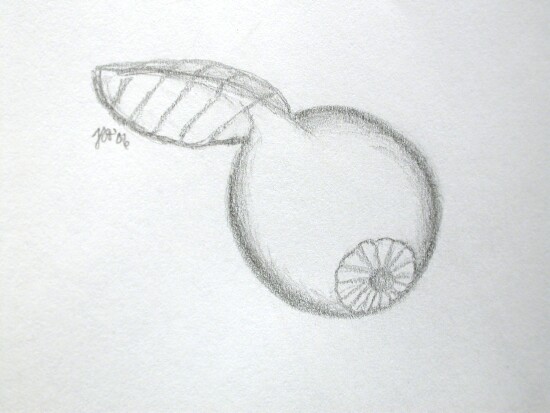 fishes* already), Cathaymyrus, Haikouella, Haikouichthys*, Yunnanozoon, Myllokunmingia*, and oddities like primeval Xidazoon for now in its own phylum Vetulicolia.
fishes* already), Cathaymyrus, Haikouella, Haikouichthys*, Yunnanozoon, Myllokunmingia*, and oddities like primeval Xidazoon for now in its own phylum Vetulicolia. 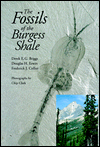 Fossils of the Burgess Shale, by Derek Briggs, Douglas Erwin, Frederick Collier
Fossils of the Burgess Shale, by Derek Briggs, Douglas Erwin, Frederick CollierWonderful Life: The Burgess Shale and the Nature of History, by Stephen Jay Gould

Common origin of the echinoderms (sea stars and urchins) and chordates (proto-vertebrates) including sea squirts: they are deuterostomes, while worms, molluscs (clams, squids and octopuses), and arthropods, are protostomes.
BCE 488 million Cambrian extinction events --> Ordovician
glaciation or gamma-ray-burst (GRB)

8-armed protostome squid meets 5-armed deuterostome seastar
BCE 444 million Ordovician extinction 1 --> Silurian -25%
 Two main hypotheses again, either a purely hypothetical gamma ray burst, depleting the ozone layer, allows the sun's ultraviolet rays to subsequently kill surface-dwelling plankton and other life near the top of the ocean, the foundation of the marine food chain. Somehow this could also have triggered an ice age?
Two main hypotheses again, either a purely hypothetical gamma ray burst, depleting the ozone layer, allows the sun's ultraviolet rays to subsequently kill surface-dwelling plankton and other life near the top of the ocean, the foundation of the marine food chain. Somehow this could also have triggered an ice age?Or, most probably (and less spectacularly), as the southern supercontinent Gondwana drifts over the South Pole, ice caps form on it, and sea levels drop.
BCE 440 million Vertebrates
Fishes

BCE 415 million Silurian --> Devonian
Bony fish and Four-Limbed Amphibians

BCE 367 million
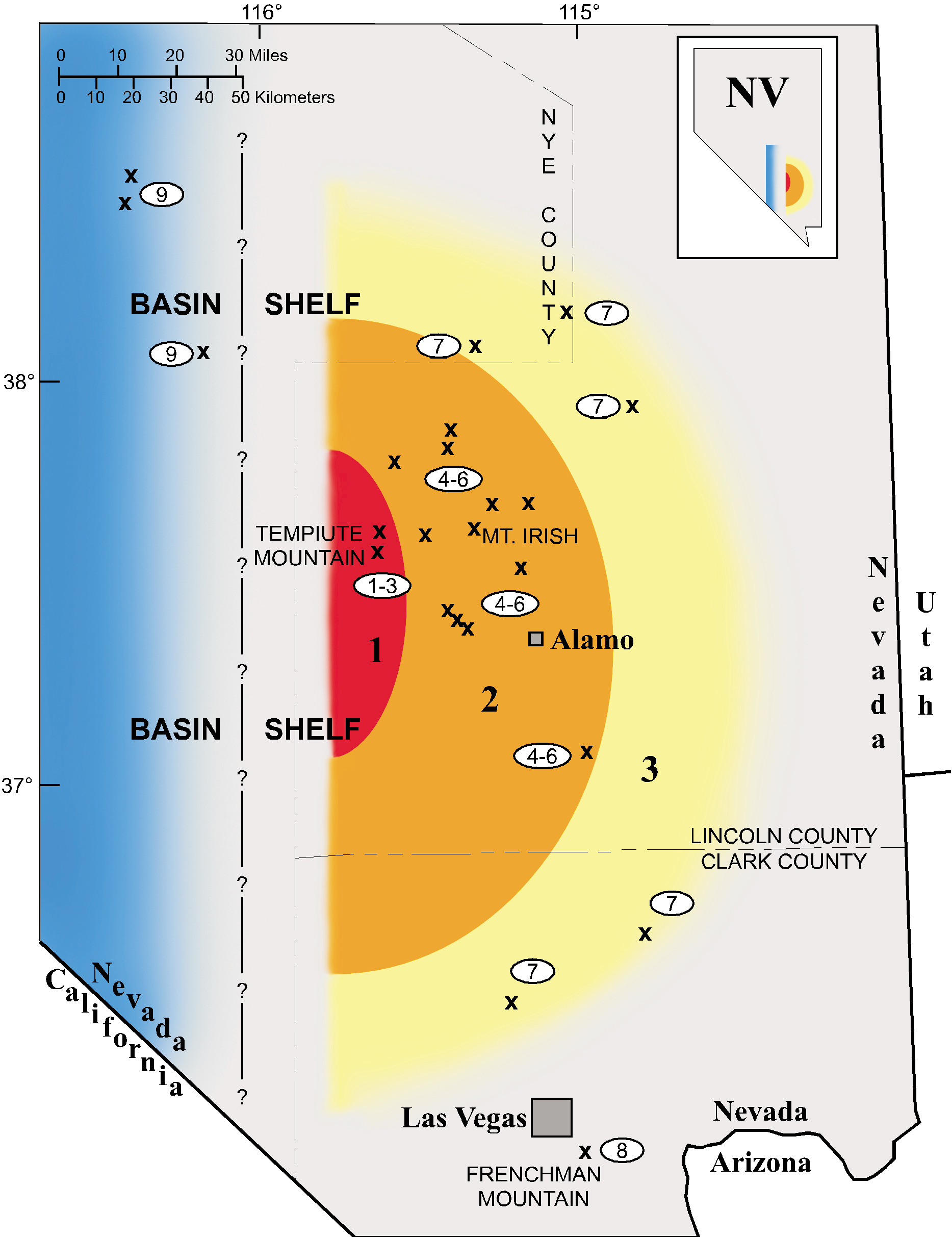 Alamo, USA, 190 km
Alamo, USA, 190 kmBCE 360 million Late Devonian extinction 2 -70%
a prolonged series of extinctions near the Devonian-Carboniferous transition, lasting perhaps as long as 20 million years, through glaciation and/or impacts:
 Aorunga, Chad, 13 km
Aorunga, Chad, 13 km Woodleigh, Australia, 40-60 km
Woodleigh, Australia, 40-60 km Siljan, Sweden, 52 km
Siljan, Sweden, 52 km Charlevoix, Canada, 54 km
Charlevoix, Canada, 54 kmCarboniferous=Age Of Coal: bark-bearing trees (with bark fiber lignin) in lowland swamps and forests, without bacteria able to digest the new lignin, are buried, into coal, while surplus oxygen buildup (to 35%) favours insect and amphibian gigantism (whose size is constrained by respiratory systems limited in their ability to diffuse oxygen).
BCE 300 million Carboniferous --> Permian

exoskeletal protostome meets endoskeletal deuterostome
BCE 290 million
 Clearwater, Canada, 36 and 26 km
Clearwater, Canada, 36 and 26 kmBCE 251 million Permian extinction 3 (Paleozoic, or Primary) --> Triassic -90%
In several waves, the core of which probably in about 80,000 years and possibly much faster, practically a split second in geological time. The problem is to distinguish causes from coincidences:
A Cluster Of Impacts - but maybe not enough sedimentary remains
 Wilkes Land, East Antartica, 500 km
Wilkes Land, East Antartica, 500 km+ meteorite fragments found in Antarctica (part of Pangea)
Bedout, off Australia, 200km

An Eruption
 As supercontinent Pangea rejoins again, a million-year-long eruption of the Siberian flood basalts, >10,000 km³, VEI=8, one of the most massive volcanic events in the last 600 million years, spills magma across an area larger than the continental United States, in some places as deep as six kilometers.
As supercontinent Pangea rejoins again, a million-year-long eruption of the Siberian flood basalts, >10,000 km³, VEI=8, one of the most massive volcanic events in the last 600 million years, spills magma across an area larger than the continental United States, in some places as deep as six kilometers.Climate Shifts
Large-scale volcanism vents large amounts of dust and carbon dioxide into the atmosphere, acidifies oceans (which dissolves invertebrates' exoskeletons) and causes first a light-filtering cooling/glaciation on Pangea (as for the previous, Ordovician and Devonian crises), then a firstr 40,000 years of global greenhouse warming (of about 5-degrees Celsius), with ocean level rises.
When global warming heats oceans enough, marine life dies out (rapidly, from Greenland's record), and frozen C12 methane clathrate gets freed and gazeified, causes marine hypoxia, and triggers a second 5-degrees Celsius step of global warming, which finishes the extinction in another 40,000 years.
Extinction: How Life on Earth Nearly Ended 250 Million Years Ago, by Douglas Erwin
The Day The Earth Nearly Died, BBC
BCE 250,000,000 Dinosaurs
end Paleozoic --> Mesozoic, Triassic
BCE 244 million
 Araguainha, Brazil, 40 km
Araguainha, Brazil, 40 kmBCE 214 million
A series of aligned impacts:

 Manicouagan, Canada, 100 km
Manicouagan, Canada, 100 km Saint-Martin, Canada, 40 km
Saint-Martin, Canada, 40 km Rochechouart, France, 23 km
Rochechouart, France, 23 km
Then on an island:
BCE 200 million Triassic extinction 4 --> Jurassic -50%
"Something suddenly killed off more than 50 percent of all species on Earth, and mammal-like reptiles, but spared the dinosaurs. Perhaps creatures reproducing with buried eggs survived and large animals with live births did not."
Theories
Possible role of impactors.
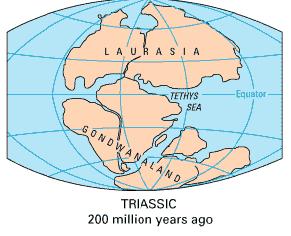 Pangea's volcanism, just before its breakup into Southern Gondwana and Northern Laurasia,
Pangea's volcanism, just before its breakup into Southern Gondwana and Northern Laurasia,released massive floods of basaltic lavas, and large amounts of volcanic greenhouse CO² gas, provoking warming that catastrophically dissociated trapped CH4 gas hydrates. Two effects of warming, the decline of the equator-to-pole temperature gradient and consequent decrease in oceanic circulation, together with the solubility of oxygen in warmer waters, may have been responsible for marine anoxia.
Once killed Thecodontians and mammal-like reptiles, the homeotherm dinosaurs were left the winners of extinctions 3 & 4.

BCE 170 million
 Puchezh-Katunki, Russia, 80 km
Puchezh-Katunki, Russia, 80 kmBCE 145 million
Jurassic --> Cretaceous
Age of Chalk and Oil and Giants
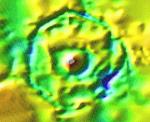 Mjølnir, Barentz Sea, off Norway, 25-40 km
Mjølnir, Barentz Sea, off Norway, 25-40 km Morokweng, Kalahari, South Africa, 70 km
Morokweng, Kalahari, South Africa, 70 kmA "minor" extinction
Supercontinent Pangea rifts apart again, into Gondwana and Laurasia

A life explosion.
Extreme Global Warming stimulates marine life growth (consuming and sequestrating carbon, reducing free CO² and Earth greenhouse ?) with exoskeleton deposits and massive algae blooms.
The deposit of marine invertebrates' calcium carbonate shells is chalk (Latin: creta), remaining in extensive beds of the upper Cretaceous of Great Britain (including the White Cliffs of Dover) and adjacent continental Europe.
BCE 145 and 90 million:
The exceptional algae blooms in stagnant rifts of the drifting continents, deposit at bottom, to be later covered and degenerate into hydrocarbon deposits of Petroleum (Rock Oil) and Natural Gas
BCE 142 million Gosses Bluff, Australia, 22 km
Gosses Bluff, Australia, 22 km
BCE 130 million Duolun, China, 70 km
Duolun, China, 70 km%20TooKoonooaka/(17)%20Tookoonooka%20Figuras%203D%20RGB%20(EX%2080).jpg) Tookoonooka, Australia, 55 km
Tookoonooka, Australia, 55 km
BCE 70 million Kara and Ust-Kara, Russia, 65 and 25 km
Kara and Ust-Kara, Russia, 65 and 25 km
The largest of the late Cretaceous craters. Manson, Iowa, USA, 37 km
Manson, Iowa, USA, 37 km
killed the giant Archelon sea turtle of the North American Western interior seaway
BCE 65 million Cretaceous extinction 5 (Mesozoic) --> Cenozoic (or Tertiary) -17%
Chicxulub, Yucatan, Mexico, 180 km
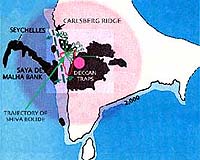 Shiva, Indian Ocean, 600 km ?
Shiva, Indian Ocean, 600 km ?
with a central peak as high as the Everest, may have triggered tectonics into the Deccan mega-eruption Boltysh, Ukraine, 24 km
Boltysh, Ukraine, 24 km Silverpit, North Sea, 15 km
Silverpit, North Sea, 15 km several impacts, spraying a cometal iridium-rich layer worldwide
several impacts, spraying a cometal iridium-rich layer worldwide
+ at the antipode in India, Deccan, eruptions pour out 2,000 km³ of magma
causing a surface heat pulse combustion and a megatsunami, killing unsheltered animals, then a climatic winter shift, then a greenhouse warming, with extinction of the biggest and most fragile, including the Dinosaurs ...
... which survive in Birds ... ![]()
The Dinosaur Heresies: New Theories Unlocking the Mystery of the Dinosaurs and Their Extinction, by Robert Bakker 

... and the winners are ...
BCE 65,000,000 Mammals
end Mesozoic --> Cenozoic
even Primate-like mammals
82-70-56-million-year-old tiny mammal ancestors were tree-living fruit eaters
Primates
BCE 53 million Montagnais, Canada, 45 km
Montagnais, Canada, 45 km
No impact on biodiversity
BCE 36 million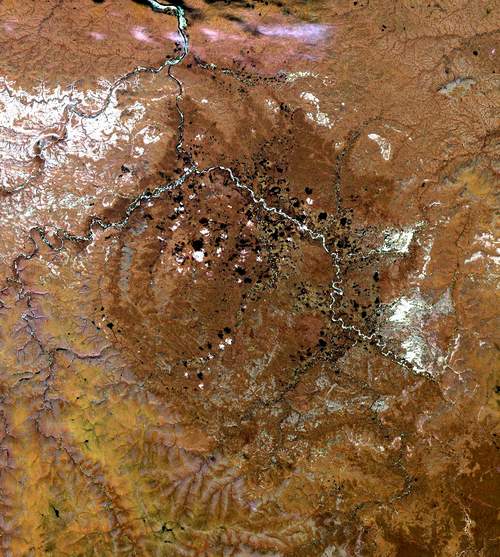 Popigai, Siberia, 100 km
Popigai, Siberia, 100 km
a cometary shower thought to have lasted for 2 to 3 million years.
BCE 36 million Chesapeake Bay, United States, 90 km
Chesapeake Bay, United States, 90 km
BCE 36 million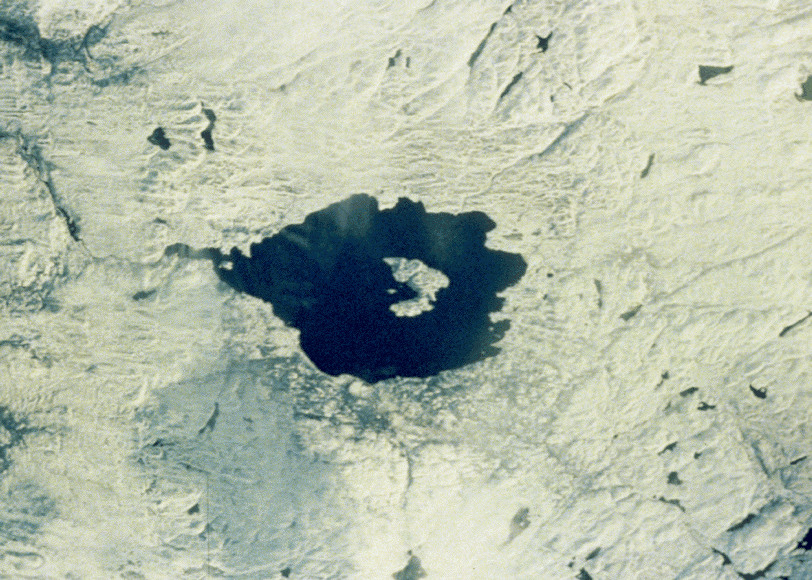 Mistastin, Canada, 28 km
Mistastin, Canada, 28 km
BCE 27 million: La Garita, Colorado, caldera explosion, 10,000 km³, VEI=8, mega-colossal, 35 by 75 km
BCE 23 million Haughton, Canada, 20 km
Haughton, Canada, 20 km
BCE 14 million: Roza basaltic flow ion, Columbia River Basalt Group, 1000 km³, VEI=8
BCE 13-8 million Apes
Orang Utang, Gorilla, Chimpanzee
BCE 10-5 million Hominids
BCE 10 million: hominid, "Forest Man" (OrangUtang) ancestor,
cousin Ramapithecus 

BCE 7 million: Toumai (Tchad), earliest Australopithecus human (3 million years before Afarensis)
BCE 5.4 million: Chimpanzee later splits from common pool
BCE 5 million Kara-Kul, Tajikistan, 52 km
Kara-Kul, Tajikistan, 52 km
BCE 5,000,000 Homo
--> Pliocene



BCE 3.2 million: Homa Australopitheca Lucy, lives in trees and on grassland
BCE 3 million: Australopithecus evolves
A catastrophic change in the global climate triggers a colder age, destroys the tree habitat of Australopithecus, but favours an innovative upright grassland adaptability.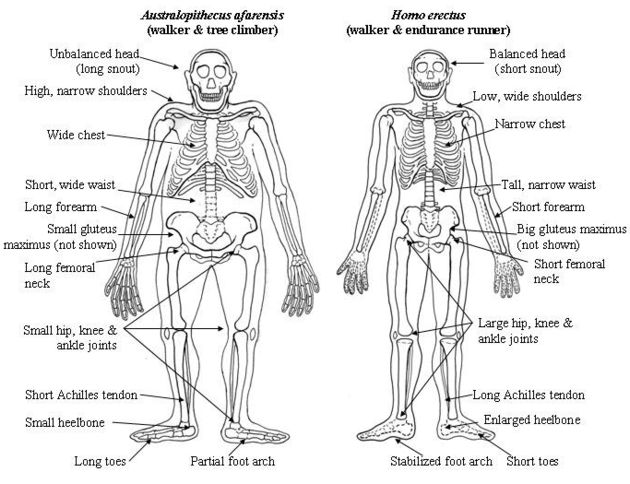
First hypothesis: an Ice Age results from the emergence of the 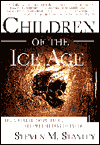 Isthmus of Panama, which blocks the Atlantic-Pacific connection, creating the Gulf Stream, a conveyor belt of cold salty water that sinks near the Arctic 0cean and goes back south, instead of carrying heat to the Arctic Ocean.
Isthmus of Panama, which blocks the Atlantic-Pacific connection, creating the Gulf Stream, a conveyor belt of cold salty water that sinks near the Arctic 0cean and goes back south, instead of carrying heat to the Arctic Ocean.
Children of the Ice Age: How a Global Catastrophe Allowed Humans to Evolve, by Steven Stanley
BCE 2.5 million: Homo Habilis Olduvai gorge, Tanzania, Africa
Olduvai gorge, Tanzania, Africa
Second hypothesis: the splitting of African from Arabian tectonic plates, somehow cools and dries the climate, eliminating forest for grassland and lakes in Africa's Great Rift valley.
Whatever the cause(s), many forest mammals don't survive the disparition of  African forests, some apes
African forests, some apes  adapt to walking and using tools, a characteric of "toolmaker" "handy" Paleolithic human.
adapt to walking and using tools, a characteric of "toolmaker" "handy" Paleolithic human. Third, the Aquatic Naked Ape hypothesis: neotenic humans free their hands and lose their fur in a rich seashore environment, comparably with other intelligent & naked mammals (elephant, dolphin, seal).
Third, the Aquatic Naked Ape hypothesis: neotenic humans free their hands and lose their fur in a rich seashore environment, comparably with other intelligent & naked mammals (elephant, dolphin, seal).![]() BBC, David Attenborough
BBC, David Attenborough
Aquatic Ape Hypothesis, by Elaine Morgan
The Naked Ape, by Desmond Morris
And a fourth hypothesis, several gamma-ray-bursts from nearby 100 light-years) Scorpius-Centaurus supernovae explosions, leaving iron-60 in Pacific sediments.
BCE 2.2 million Yellowstone caldera eruption, 2500 km³ (mega-colossal, VEI=8)
Yellowstone caldera eruption, 2500 km³ (mega-colossal, VEI=8)
 a 'volcanic winter' ice age, the Pleistocene, of ELE/ evolutive level, freezes waters and lowers oceans, uncovering rich linked seashore habitats in the warmer tropical regions
a 'volcanic winter' ice age, the Pleistocene, of ELE/ evolutive level, freezes waters and lowers oceans, uncovering rich linked seashore habitats in the warmer tropical regions
BCE 2.1 million Eltanin, South Pacific, 135 km
Eltanin, South Pacific, 135 km
5 km underwater now; a 1-4 km diameter asteroid into the Southern Ocean, 1500 km SW of Chile, produces a 200–300 m high tsunami to the Antarctic Peninsula and the southern tip of South America 1200–1500 km away, 60 m waves strike New Zealand 6000 km away.
BCE 1.8 million: Homo Erectus (upright) walks first out of Africa (well before the Sapiens bottleneck), adapted for along the warm
walks first out of Africa (well before the Sapiens bottleneck), adapted for along the warm water shores
water shores
It is the first diaspora, of now
Extinct Humans, by Ian Tattersall, Jeffrey Schwartz
BCE 1.4 & 1 million Valles Caldera, New Mexico, caldera mega-explosions, 1000 km³, VEI=7
Valles Caldera, New Mexico, caldera mega-explosions, 1000 km³, VEI=7
BCE 1.3 million & 640,000: more Yellowstone caldera mega-explosions, 280 & 1000 km³,  VEI=7, spread ash over North America. Global volcanic winter, starvation lasting for years.
VEI=7, spread ash over North America. Global volcanic winter, starvation lasting for years.
Nobody there, Homo is still crawling on the other continental mass.
BCE 1.3 million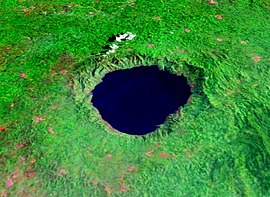 Bosumtwi, Ghana, 8 km
Bosumtwi, Ghana, 8 km
BCE 1,000,000 Fire
and cooking are found in Kenya's Rift Valley maybe from BCE 1,400,000, in South Africa from BCE 1,000,000, in Israel from BCE 800,000, in Europe from BCE 250,000
Keeping a fire alive was an insightful art, requiring the realisation that fire consumed fuel, which led to the logical conclusion that new fuel needed to be added to keep the fire from going out, and an astute awareness that once the fire was out, its benefits would be lost, with possible disastrous consequences.
How Homo Became Sapiens: On the Evolution of Thinking, by Peter Gardenfors
BCE 900,000 Zhamanshin, Khazakstan, 13 km
BCE 870,000 up to 5 impactors, Antarctica, 350 km ? (under investigation)
up to 5 impactors, Antarctica, 350 km ? (under investigation)
During an Ice Age, supposedly only vaporized ice and caused no widespread extinction
BCE 640,000: third Yellowstone caldera mega-explosion, 1000 km³, VEI=7, spreads ash over North America
BCE 560,000 Cumbre Vieja, Canarys, Atlantic, landslide and tsunami

BCE 400-200,000 European North Sea junction through an 11-km-high Flood severing future Britain from France
BCE 250-160,000: Homo Sapiens
from Africa, develops cultures and 
 technologies, and also populates the world, despite climate shifts
technologies, and also populates the world, despite climate shifts
BCE 120,000: El Hierro, Canarys, Atlantic, landslide and megatsunami, 50 m high
So much for those on the Atlantic coast.
BCE 230,000-185,000-120,000-70,000 Sapiens' Ice Ages


BCE 100,000 Skhul cave, Israel
early jewelry & art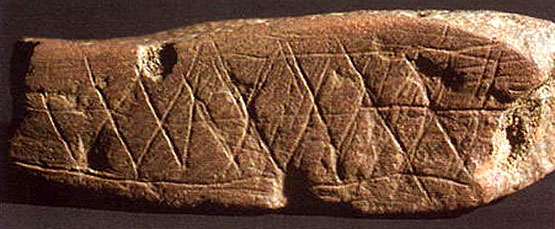
BCE 77,0000 Blombos cave, South Africa
small portable engraved ochred stone (artefact)
BCE 82,000-42,000 Divje Babe cave, Slovenia
cave bear bone diatonic flute
BCE 71,000 Toba, Sumatra, supervolcano eruption, 1,000 km³ (VEI=8) Sumatra's Mount Toba's caldera explodes with an energy of 1 Gton of TNT, the largest volcanic eruption since the big Permian extinction, 250 million years ago, and causes a six-year global volcanic winter (summer temperatures drop by 12 to 21 degrees, and 75 percent of the Northern Hemisphere's plants die), followed, through the usual albedo feedback, by a thousand-year ice age.
Sumatra's Mount Toba's caldera explodes with an energy of 1 Gton of TNT, the largest volcanic eruption since the big Permian extinction, 250 million years ago, and causes a six-year global volcanic winter (summer temperatures drop by 12 to 21 degrees, and 75 percent of the Northern Hemisphere's plants die), followed, through the usual albedo feedback, by a thousand-year ice age.
The previous Erectus (almost completely, see Ngandong and maybe Flores men) & Sapiens diasporas, downwind around the Indian Ocean, are (almost) wiped out, perhaps only 2,000 individuals survive, in isolated tropical refuges mainly in Equatorial Africa, explaining the mitochondrial "Eve" human genetic bottleneck and subsequent rapid differenciation of human races.
in isolated tropical refuges mainly in Equatorial Africa, explaining the mitochondrial "Eve" human genetic bottleneck and subsequent rapid differenciation of human races.

Dissemination of "Eve" (mitochondrial) and "Adam" (Y chromosome) DNAs
Through the Bottleneck
Volcanic Winter & Differenciation
Supervolcanoes, BBC
Single Origin Theory
Before the Dawn: Recovering the Lost History of Our Ancestors, by Nicholas Wade
BCE 55-40,000 Migrating into Europe, and across S-E Asia and  Central Asia, Homo Sapiens Sapiens (Cro-Magnon) replaces (or merges with and supercedes) Neanderthal
Central Asia, Homo Sapiens Sapiens (Cro-Magnon) replaces (or merges with and supercedes) Neanderthal
BCE 30,000-14,000
Transcendental shamanism, symbolic and astrotheological petroglyph & cave art in Europe (Chauvet, Lascaux, Altamira)
BCE 14,500 The famous pit scene at Lascaux represents the basic paleolithic shamanic astrotheology, of an inner ecstatic experience directly related to the observable night-sky macrocosmos.
It is winter, at solstice, when nature dies and is reborn, when the sun, the great male god, the bison, as if mortally wounded, nears its shortest day and extreme sunrise point on the horizon, then, after stopping its course for three days (Latin: sol, the sun, and stare, to stop), is reborn and rises higher on the horizon again for a new fertile year.
The shaman, having probably ingested an entheogen mushroom as Psilocybe or seasonal Amanita, and maybe anointed himself with a psychoactive plant concoction, for three days isolated and naked in the deepest recess of the motherly Earth womb, as a buried dead and as a near-term child, on a white shroud as a Lazarus, reclines in trance, his arms outstretched in a cross, near his trusted totemic bird-staff, and visualises familiar animals.
Through the illusive veil of painted rock, he interacts with the superior reality beyond his measly preplatonic cave, the astrological macrocosmos, much as 14,500 years later Mithraists outside-in their own astrotheological cavern. His bird is his totemic guide, his psychopomp, and himself is transformed into his totem, probably with the help of the entheogen, much as flying witches, 15,500 years later, with dysesthesia (strange feelings) of feathers and of flying.
He becomes the bird, and sets for a flying journey, of sympathetic death and rebirth, in phase with the cycling year, and probably hopefully with the ecological worries of a time of deglaciation, towards the big celestial Bird, Cygnus/Vulture constellation, on the Milky Way, the luminous celestial ancestor river, and towards the Northern head and eye of the Bird, the brilliant star α Cygni/Deneb, the Polar Star of BCE 14,500, immobile and eternal axis of the daily rotating skies, 'stargate' 'chimney' exit of the universe.  In the sky, his little bird-scepter is now either Delphinus constellation, then seen as a Bird, amongst adjacent Aquila constellation/Flying Vulture and Lyra/Falling Vulture; or the bird's eye could be brilliant α Aquilae/Altair (Arabic: the flyer) of Aquila.
In the sky, his little bird-scepter is now either Delphinus constellation, then seen as a Bird, amongst adjacent Aquila constellation/Flying Vulture and Lyra/Falling Vulture; or the bird's eye could be brilliant α Aquilae/Altair (Arabic: the flyer) of Aquila.
The arrow at his feet is either Sagitta constellation (which Hercules constellation will later use to kill these Stymphalian Birds), or Ophiuchus' tail, and, as Ophiuchus is the powerful Earth snake (and was later initiate physician Asclepius), possibly a poisoned arrow, inducing a fake death, an ecstatic trance, upon the shaman himself (as the Bison already has his arrow), even, maybe, the poison itself, an elongated entheogen psilocybe cubensis mushroom, from wild grazers as the rhinoceros, or a winter amanita, sprouting from the ground just above the horizon line (the Bison's arrow), or/and lying at the shaman's side during his trance voyage.
The giant Bison/European Aurochs is constellations Lyra with α Lyrae/Vega as his bright eye or red nose, ν Draconis/Kuma head of Draco, Hercules, Bootes, Virgo; his bowels are Libra/Air(ful). Bison symbolizes Two, Right, West, Male, Solid, Earth.
The Bison's long arrow (which doesn't explain disembowelment, this is all symbolic), could mark the horizon or the solar system celestial equator plane; disappearing under the horizon is for the Bison, as for the sun, like getting wounded or dying, with his Libra air-bowels hanging down into the underworld (like liminal trickster Coyote, the Southern hemisphere Inca dark cloud, upside-down in nearby Scorpio constellation, got in trouble in precessional Big Time, with his tail flooded from "under" the celestial equator).
Bison/α Lyrae/Vega, Shaman/α Cygni/Deneb, and Bird/α Aquilae/Altair, the three 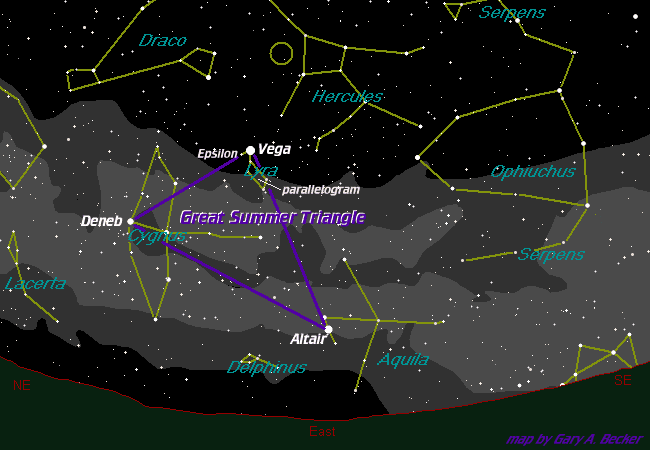 brightest stars visible in summer, on the Milky Way, compose the "Summer" Triangle asterism, although notedly what we now see in summer, was the winter sky half a 26,000 years precession cycle ago, centered with Cygnus slightly to the right. The scene represents the winter solstice in BCE 14,500.
brightest stars visible in summer, on the Milky Way, compose the "Summer" Triangle asterism, although notedly what we now see in summer, was the winter sky half a 26,000 years precession cycle ago, centered with Cygnus slightly to the right. The scene represents the winter solstice in BCE 14,500.
The left-side/Western grazing woolly rhinoceros, is part Pegasus constellation, another flying grazing quadruped, part Aquarius; a peaceful female Unicorn, a celestial counterpart of the male Bison, symbolizing One, Left, East, Female, Water, Ocean.
Between Unicorn and Aurochs stands the Milky Way, symbolizing the metaphysical illuminating middle-way of souls (the stars constitutive of the running animals of the cave seen in their superior reality through the illusive veil of rock), the Lascaux North-South cave, and the North-South glaciers of paleolithic Europe including the river Rhône frozen in winter and its valley run by hordes of animals.
She-Unicorn/Rhinoceros and He-Bison/Auroch, united by the Milky Way as in a Rebis/hermaphrodite rebus, fill up all the sky West and East, they are gigantic all-encompassing constellations; there is nothing known below, as Bison's arrow delineates the horizon line from which Bird-staff and Arrow/Plant/Mushroom emerge; and there appears to be nothing above, corresponding to Draco and the Bears, geographically on Earth the Northern ice-age glacier limit.
In Earth geography, Unicorn might be the paleolithic Atlantic Ocean, closed North by the ices and navigable on its then stable thermohaline circulation Gulf Stream, with the majestic woolly rhinoceros horn representing the paleo-Mississippi delta into a then narrower Gulf of Mexico, while Aurochs might be the (Eur)Asian continent, with his bowels hanging below Lascaux horizon, representing the South-East of Asia Sundaland being inundated by the rising deglaciation oceans (with a first sudden Deluge around BCE 14,800 from North American Bonneville lake draining into the Pacific with first a megatsunami/megaflood), astrotheologically a typical precessional Deluge.
There might be a bigger motivation to the ceremony than the usual end-of-year reenactment, as climate in BCE 14,500 is changing, with thawing permafrost), inaccessible cloudy sky, ocean rise inexorably submerging shallow coastlines, the first sudden undeniable world flood around BCE 14,800. Lascaux paleolithic shamans partake with their precessionnal opposites, the Incas, nearly the same spectacularly clear winter solstice sky, but also the eschatological) Big Worry, worthy of top Big-Time shamanism. Alone in the underground pit/throne/cathedra/cockpit of Lascaux, the shaman is intrepidly fighting with sympathetic magic a great Space/Time battle against the end of the world as we knew it (TEOTWAWKI).
After three days like dead in his underground Lascaux pit, retracing in a flight the mystical and macrocosmic drama, the shaman resurrects, like the natural year. The Bison himself probably does not really die either, he resurrects, in his dayjob as the sun.
Microscosmos and Macrocosmos are one, this mystical experience must be true.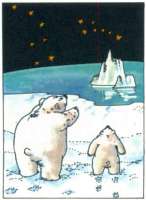 Lascaux panorama is simultaneously: the first astrotheological sky map showing the shamanic paradigm of spiritual ascension, and maybe wisdom pilgrimage, at the source of later world religions; the first known world map, extending, across the Atlantic to the paleo-Mississippi (as Rhinoceros' horn), and across Eurasia to South-East Asia (as Aurochs' hanging bowels); the first Christmas (s)cene, with the first Christ avatar; the first identified Ideogram depiction; the first symbolism of 3 or 4 complimentary elements; and probably the first global responsible consciousness of climate stake (although on a sympathetical magical mode). Lascaux cave is the first cathedral, an artistic chef-d'oeuvre, a fundamental shrine to humanity.
Lascaux panorama is simultaneously: the first astrotheological sky map showing the shamanic paradigm of spiritual ascension, and maybe wisdom pilgrimage, at the source of later world religions; the first known world map, extending, across the Atlantic to the paleo-Mississippi (as Rhinoceros' horn), and across Eurasia to South-East Asia (as Aurochs' hanging bowels); the first Christmas (s)cene, with the first Christ avatar; the first identified Ideogram depiction; the first symbolism of 3 or 4 complimentary elements; and probably the first global responsible consciousness of climate stake (although on a sympathetical magical mode). Lascaux cave is the first cathedral, an artistic chef-d'oeuvre, a fundamental shrine to humanity.
BCE 25-22,000 Migration across frozen Beringia into North America
BCE 22,000 Aira, South Japan, caldera explosion, 1,000 km³, VEI=7
BCE 17,000 Australia Bradshaw rock paintings
BCE ? 100,000-11,000 ? Carolina Bays theory, USA Atlantic coast Many (500,000 to 2,5 million) oblong depressions might correspond to a complex impact cluster, just beyond the ice margin, potentially
Many (500,000 to 2,5 million) oblong depressions might correspond to a complex impact cluster, just beyond the ice margin, potentially contributing to the extinction of large North American mammals (sabre toothed cats, mammoths, mastodons, giant sloths, giant beavers, horses, camels, bears, ...). Datation is controversial and might go back to the BCE 100,000-70,000 range, and other mechanisms
contributing to the extinction of large North American mammals (sabre toothed cats, mammoths, mastodons, giant sloths, giant beavers, horses, camels, bears, ...). Datation is controversial and might go back to the BCE 100,000-70,000 range, and other mechanisms are possible.
are possible.
Further theory makes this a CLE, maybe triggering ice melting, causing the tsunami-and-slide disparition of a former ice age Atlantean tropical seafaring civilization.
BCE 11,000 Civilization
Pleistocene --> Holocene
BCE 11,000-8,000 End of Glaciation
The Long Summer: How Climate Changed Civilization, by Brian Fagan
Millenia-long diluvial ocean rises, until BCE 5,500, impact civilizations, favouring inland refuges, and repetitively wiping out vulnerable shores. 

Postglacial Floods:
Ocean Rise & Megatsunamis
Shores' unstability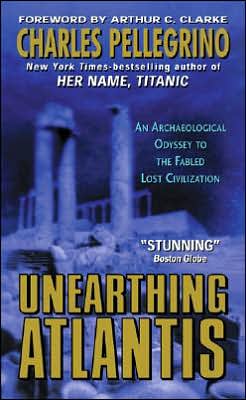 Atlantis Underwater Hypothesis
Atlantis Underwater Hypothesis
Seafaring
Astronomy
Inland's refuge
Agriculture & Urbanization overshoots
Sundaland/Jomon pottery
Neolithic and Megalithic cultures
Languages
Writing defines History, Written Religions
Agriculture and Languages: Wheat from Upper Mesopotamia and Rice from Sundaland
BCE 9000 Inland, drought and Neolithic revolution, in levantine corridor Jericho and Upper Mesopotamian (UM)/Anatolian "Pre-Pottery Neolithics" (PPN)
Inland, drought and Neolithic revolution, in levantine corridor Jericho and Upper Mesopotamian (UM)/Anatolian "Pre-Pottery Neolithics" (PPN)
Big cultivated seeds, little wild seeds
 BCE 9000 Göbekli Tepe stone temple
BCE 9000 Göbekli Tepe stone temple
BCE 8000 Nevali Cori
BCE 7200-6800 Cayonu, Jarmo, metal tools, plants and animals domestication.
BCE 7000-5500 Catal Huyuk, Anatolia
Inland religion in Anatolia and UM shows, besides classical themes as fertility and astrological goddesses and gods, a remarkable continuity in basic shamanistic mythology, of mystical and
as fertility and astrological goddesses and gods, a remarkable continuity in basic shamanistic mythology, of mystical and 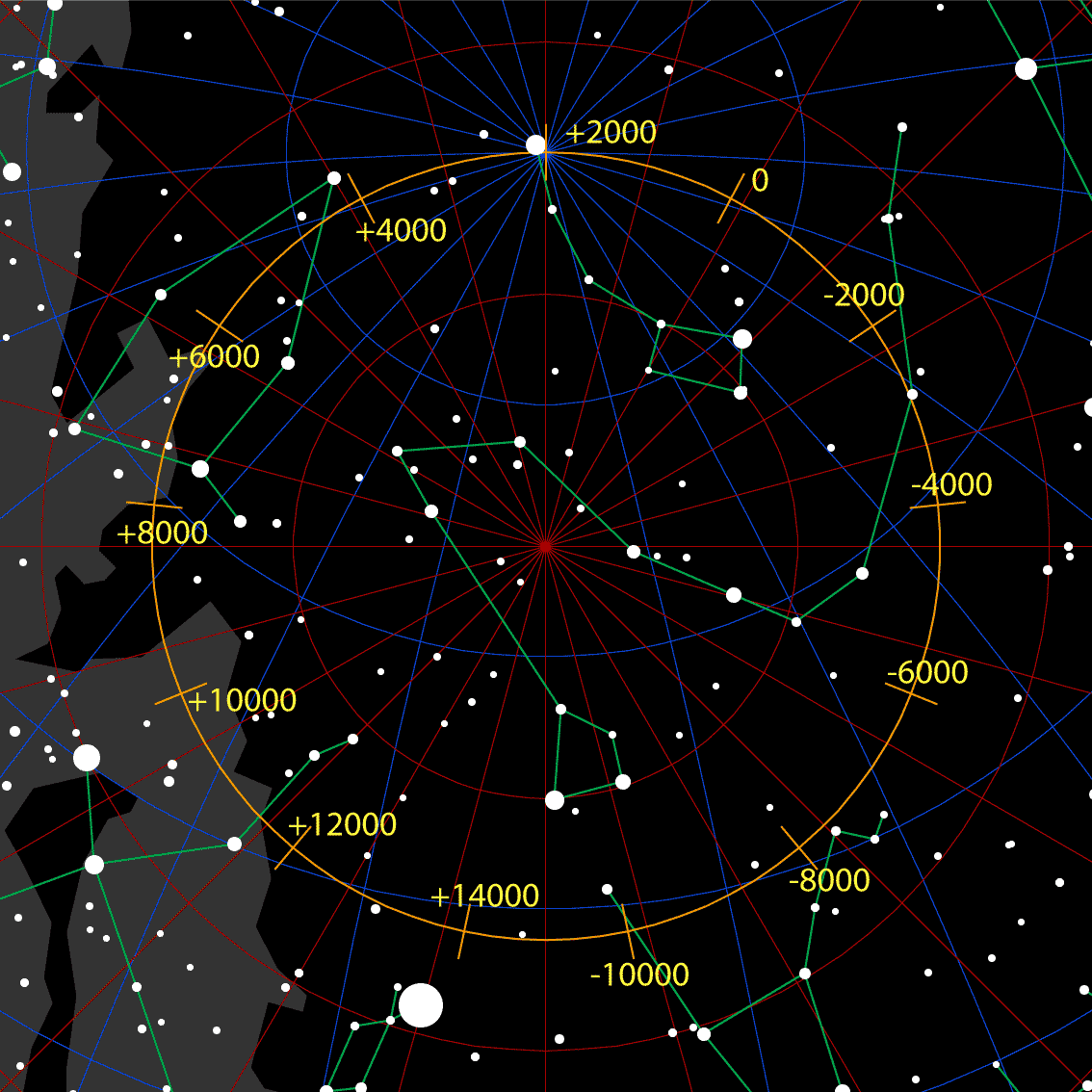 astrotheological ascension from earth, on an axis mundi, through a psychopomp bird, through a new polar celestial bird, the brightest Vega/α Lyrae of Falling Vulture/Vultur Cadens/Lyra constellation, to a luminous polar "chimney" cosmic exit, like in BCE 14,500 shamanic paleolithic cave art at Lascaux with the previous precessional polar Bird, Tundra Cygnus. Entheogen enhancement use is plausible, although
astrotheological ascension from earth, on an axis mundi, through a psychopomp bird, through a new polar celestial bird, the brightest Vega/α Lyrae of Falling Vulture/Vultur Cadens/Lyra constellation, to a luminous polar "chimney" cosmic exit, like in BCE 14,500 shamanic paleolithic cave art at Lascaux with the previous precessional polar Bird, Tundra Cygnus. Entheogen enhancement use is plausible, although  not documented.
not documented.
From paleolithic shamanism, to BCE 9000 UM Zagros mountains Zawi Chemi Shanidar transition from paleolithic ritual use 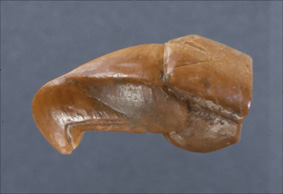 of predator birds wings, to vulture cult at BCE 9000 Göbekli Tepe and BCE 8000 Nemrik, to vulture
of predator birds wings, to vulture cult at BCE 9000 Göbekli Tepe and BCE 8000 Nemrik, to vulture excarnation and/or death-trance shamanism at Catal Huyuk,
excarnation and/or death-trance shamanism at Catal Huyuk,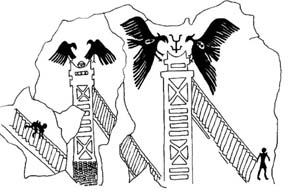
to Indo-European and classical antique middle East winged sun, to
to  Persian then Indian Zoroastrian Parsi winged guardian spirits (Fravashi) and vulture excarnation, UM
Persian then Indian Zoroastrian Parsi winged guardian spirits (Fravashi) and vulture excarnation, UM dualistic gnostic Mandaeist saviour spirits, and Kurdish syncretist Yezidi birdlike angel-god (Melek Thaus) and bird on a brass staff (sanjaq).
dualistic gnostic Mandaeist saviour spirits, and Kurdish syncretist Yezidi birdlike angel-god (Melek Thaus) and bird on a brass staff (sanjaq). 
 Filiation to angels, dovish holy spirits, and caduceus.
Filiation to angels, dovish holy spirits, and caduceus.
BCE 11,000-6,000 meanwhile is, seawards, a period of recurring geographical change, as ocean levels rise continuously and in diluvian/atlantean steps (punctuated equilibrium, jumps) from the end-glacial ~-100 m, covering coastal settlements and harbours in water and sediment, and several times through brutal tsunamis
(punctuated equilibrium, jumps) from the end-glacial ~-100 m, covering coastal settlements and harbours in water and sediment, and several times through brutal tsunamis  repetitively due to the release of giant continental North American glacial lakes (Bonneville BCE 14,800-12,500; Lahontan ?; Missoula and Columbia westwards
repetitively due to the release of giant continental North American glacial lakes (Bonneville BCE 14,800-12,500; Lahontan ?; Missoula and Columbia westwards BCE 13,000-11,000; Agassiz east/northwards BCE 11,000 and 6,200; Ojibway BCE 6,200)
BCE 13,000-11,000; Agassiz east/northwards BCE 11,000 and 6,200; Ojibway BCE 6,200)  and a few North European glacial lakes (Scandinavian Baltic BCE 11,000 and 7,200), and due
and a few North European glacial lakes (Scandinavian Baltic BCE 11,000 and 7,200), and due  to earth crust isostatic decompression rebound.
to earth crust isostatic decompression rebound.
The result is a recurring historical and archeological amnesia, leaving only inland continuity of sites, underwater tropical ruins, oral memory of ages ending in deluge and accompanying imaginative myths and astrotheology, and secret seafaring traditions.
![]()
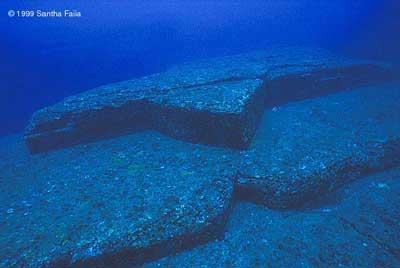
The turtle, with its round shell, like heaven, and its flat bottom, like earth, symbolizes the living world surviving the flood. As the traditional second reincarnation Kurma of Indian Vishnu, it reemerges after the great flood, as foundation of the new time and world axis, for the churning of the sea of milk into immortality nectar, a psychopomp entheogen. A very old turtle symbol is found at both extreme origin points of diluvian Eurasia, Nevali Cori on the western Anatolian wheat origin region, and Yonaguni on the eastern Taiwanese rice origin region.
 Gulf of Cambay former Saraswati valley, India
Gulf of Cambay former Saraswati valley, India
Underwater city A questionable BCE 7,500 datation is obtained but from aspecific wooden debris which could have floated from elsewhere
A questionable BCE 7,500 datation is obtained but from aspecific wooden debris which could have floated from elsewhere

 Sino-Japanese late Sundaland, bridge road and underwater ruins as Yonaguni and Penghu
Sino-Japanese late Sundaland, bridge road and underwater ruins as Yonaguni and Penghu


 Caribbeans, underwater harbours and roads
Caribbeans, underwater harbours and roads
BCE 6200 .jpg) giant glacial lakes Agassiz and Ojibway, Canada, drain again (northwards through Hudson Bay, eastwards through the St. Lawrence valley) into an Atlantic tsunami rise, and perhaps triggering a North Atlantic thermohyaline circulation (THC) shutdown with cooling.
giant glacial lakes Agassiz and Ojibway, Canada, drain again (northwards through Hudson Bay, eastwards through the St. Lawrence valley) into an Atlantic tsunami rise, and perhaps triggering a North Atlantic thermohyaline circulation (THC) shutdown with cooling.
BCE 5500 
 Black Sea Deluge (into Gilgamesh's anoxic dead sea) & diasporas
Black Sea Deluge (into Gilgamesh's anoxic dead sea) & diasporas
Noah's Flood: The New Scientific Discoveries About The Event That Changed History, by William Ryan, Walter Pitman
After the last water rise and the spectacular Black Sea saltwater invasion, interconnected antique urban and commercial civilizations can develop and persist.
BCE 4,300 Kikai, Japan, caldera explosion, 1000 km³, VEI=7
BCE 4,200 Crater Lake, Oregon, caldera explosion, 1000 km³, VEI=7
BCE 2350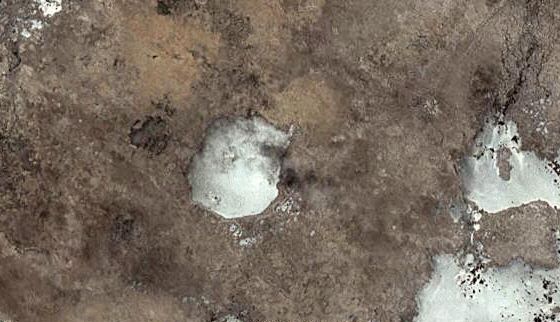 Umm al Binni, Iraq, 3 km
Umm al Binni, Iraq, 3 km
into then a shallow sea, potentially only part of a shower of meteors, powerful like an H bomb into the "cradle of civilization". A 3 km diameter corresponds, in deplaced volume, to "only" a VEI=5-to-6 event, but still ten times more powerful than the most powerful bomb detonated above ground in the modern times, and strategically located.
The best candidate for an historically significant impactor event, as archaeological 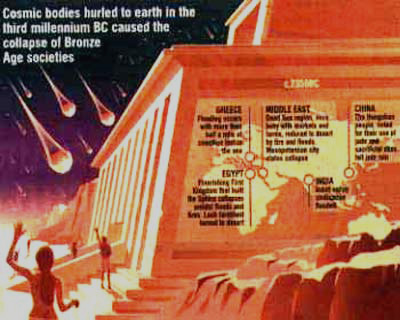 and litterary data correspond to describe a synchronous worldwide "winter" ecological catastrophy and collapse of stable and urbanized Bronze Age civilizations, in Mesopotamia and Egypt, Greece, China. Any environmental downturn lasting longer than about three years tends to bring down agriculture-based civilisations, that can only survive as long as their stored food reserves. Sudden inundations (by tsunami ?), lasting drought, desertification, forest fires, hopelessness, starvation, records and memory loss, dark age. Probable preceding urban overshoot and fragility.
and litterary data correspond to describe a synchronous worldwide "winter" ecological catastrophy and collapse of stable and urbanized Bronze Age civilizations, in Mesopotamia and Egypt, Greece, China. Any environmental downturn lasting longer than about three years tends to bring down agriculture-based civilisations, that can only survive as long as their stored food reserves. Sudden inundations (by tsunami ?), lasting drought, desertification, forest fires, hopelessness, starvation, records and memory loss, dark age. Probable preceding urban overshoot and fragility.
In Mesopotamia: luminous sky phenomena, sudden floods, 300-year drought and desertification, recurrent crop failures, high prices, cities failure, city-states failure, collapse of once all-powerful Akkadian empire (Akkad=Babylon), invasion by mountain people.
A thin layer of volcanic ash covers the last Akkadian mud bricks. Just above that a layer of fine sand eight inches thick testifies to centuries of flailing wind and relentless drought, then a thick layer of lifeless dirt, even the earthworms die out.
A Deluge from the Epic of Gilgamesh, circa 2200 BCE: "... and the seven judges of hell ... raised their torches, lighting the land with their livid flame. A stupor of despair went up to heaven when the god of the storm turned daylight into darkness, 
when he smashed the land like a cup. ... One whole day the tempest raged, gathering fury as it went, it poured over the people like the tides of battle."
The “Curse of Akkad,” circa 2200 BCE (from Ur-adversary Sumer): “flaming potsherds rain from the sky”, then
"For the first time since cities were built and founded,
The great agricultural tracts produced no grain,
The inundated tracts produced no fish,
The irrigated orchards produced neither syrup nor wine,
The gathered clouds did not rain, the masgurum did not grow.
At that time, one shekel's worth of oil was only one-half quart,
One shekel's worth of grain was only one-half quart ...
These sold at such prices in the markets of all the cities!"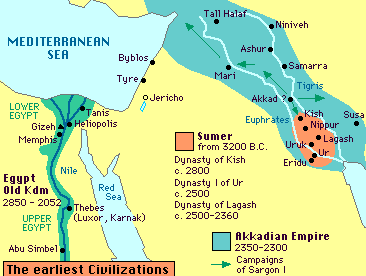
In Egypt, desertification, abandon of sterile fields, after Pepy II who had ruled for more than 90 years, fall of the Old Kingdom of discredited powerless pharaohs, many during the three decades of the Seventh and Eighth Dynasties ruling for only a year or two, the kingdom splinters into feudal states, marauding bands of robbers and starving people search for food, foreigners settle, disease and sterility.
"The sun is occluded and will not shine that men may see... none may know that it is midday, and the sun will cast no shadow."
Sage Ipuwer: "Lo, the desert claims the land. Towns are ravaged ... Food is lacking ... Ladies suffer like maidservants." 
Southern governor Ankhtifi: "all of Upper Egypt is dying of hunger to such a degree that everyone has come to eating their children".
A positive light would be that the crisis instilled a spirit of social justice and laid the foundation for compassion as virtue.
In the Jewish bible (old testament): several plagues from the sky (from impact or eruption), an exodus following a luminous heavens angel with a sword (a comet ?). Traditional datation sees such events later, during the new Egyptian kingdom; several events could be confounded into the same myth.
plagues from the sky (from impact or eruption), an exodus following a luminous heavens angel with a sword (a comet ?). Traditional datation sees such events later, during the new Egyptian kingdom; several events could be confounded into the same myth.
In the Indus: the great Saraswati-Indus valley cities decline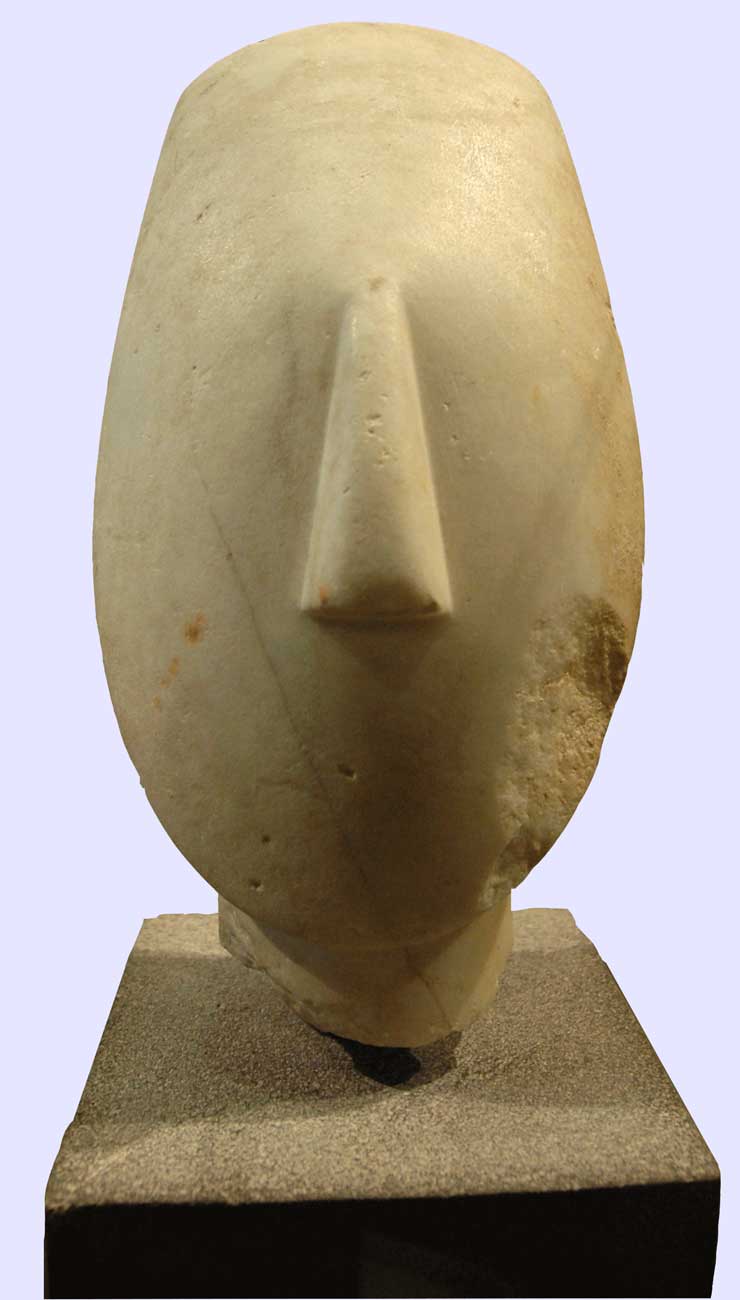 , Indo-Europeans immigrate.
, Indo-Europeans immigrate.
A Peaceful Realm : The Rise And Fall of the Indus Civilization, by Jane McIntosh
The Ancient Indus Civilization, Embodying Indus Life: Terracotta Figurines From Harappa
Burckle crater, Indian Ocean, 31 km (investigated)
In Greece and Crete: decline of the neolithic Cycladics, start of dry-climate olive cultivation, rise of Cretan palatial Minoans.
Cyclades, by Bérénice Geoffroy-Schneiter
In Europe: mini-ice age, pyramids with Silbury Hill pregnancy cult at Avebury
In China: population decrease, decline of the Yellow River neolithic Longshan culture, emergence of the Xia dynasty, whose founder Yu reportedly conducts the Chinese "Harris" world ("Everything Under Heaven") map and survey (Shan Hai Jing, Book of the Mountains and Seas).
In South America: decline  at Caral, the oldest city in the Americas, without pottery nor maize yet; end of the mound builders of the Amazon headwaters and of the mountains; beginnings of the Titicaca pilgrimage, the Maya, the Olmecs, and the Teotihuacan.
at Caral, the oldest city in the Americas, without pottery nor maize yet; end of the mound builders of the Amazon headwaters and of the mountains; beginnings of the Titicaca pilgrimage, the Maya, the Olmecs, and the Teotihuacan.
Rio Cuarto, Argentina, 1.2 km
"teardrops of the pampa" from a possible tangential impact in the same BCE 2350 period
Umm al Binni lake, a possible Holocene impact structure in the marshes of southern Iraq: Geological evidence for its age, and implications for Bronze-age Mesopotamia, by Sharad Master (now that's a compelling name)
Collapse of Early Bronze Age civilisations: has the smoking gun been found?
Natural Catastrophies During Bronze Age Civilizations: Archaeological, Geological, Astronomical and Cultural Perspectives, by Benny Peiser
The late Third Millennium BC civilisations collapse, by Timo Niroma
Empires in the dust, collapse of Bronze Age cultures in 2,200 A.D, by Karen Wright
BCE 1650: Thera-Santorini, Greece, eruption and caldera explosion, 1000 km³, VEI=7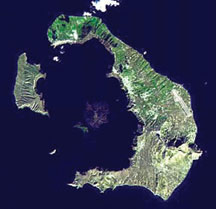 One of the largest in the last 10,000 years, sends a tsunami and ashes over the eastern Mediterranean and Turkey, and destroys the Minoan thalassocracy of Crete.
One of the largest in the last 10,000 years, sends a tsunami and ashes over the eastern Mediterranean and Turkey, and destroys the Minoan thalassocracy of Crete.
The End of Atlantis: New Light on an Old Legend, by J. Luce
This catastrophy is also a suspect in mythical events, as biblical plagues of Egypt and the exodus (dust and darkness, sea parting as in a tsunami), and the composite platonician myth of Atlantis.
![]() BCE 1200-1000: modern phonetic Alphabets
BCE 1200-1000: modern phonetic Alphabets![]()
BCE 500's Philosophers century
Mahavira & Buddha, Lao-Tsu & Confucius, Pythagoras & Socrates
The Shape of Ancient Thought: Comparative Studies in Greek and Indian Philosophies, by Thomas McEvilley
CE 325 council of Nicea, 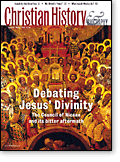 Byzantine emperor Constantine sides with dogmatic Christianism into a state monotheism.
Byzantine emperor Constantine sides with dogmatic Christianism into a state monotheism.
Monotheism and theocracy had existed before, but never in such a fateful proselytism.
CE 536 proto-Krakatau, Indonesia, 200 km³, VEI=6, exacerbates "Dark Ages" Volcanic caldera explosion, 300 million tons of aerosols, separation of Java and Sumatra
Volcanic caldera explosion, 300 million tons of aerosols, separation of Java and Sumatra
Domino-like, global Volcanic "Winter" and severe plague epidemic hit Africa, Europe and Asia from 541 to 544, killing 20 to 25 percent of the population, disrupting the Chinese disorder (Chinese historian: "obscure skies and summer frost") and the vacillating Roman-Byzantine Empire (the bishop of Ephesus writes: "The sun became dark... Each day it shone for about four hours and still this light was only a feeble shadow."), the Persio-Arabians and the Nasca, and inspiring myths of king Arthur and Beowulf.
Roman-Byzantine Empire (the bishop of Ephesus writes: "The sun became dark... Each day it shone for about four hours and still this light was only a feeble shadow."), the Persio-Arabians and the Nasca, and inspiring myths of king Arthur and Beowulf.
Catastrophe: An Investigation into the Origins of Modern Civilization, by David Keys
Were the Dark Ages Triggered by Volcano-Related Climate Changes in the 6th Century, by Ken Wohletz
So these were literally dark ages.
CE 1350 Great Plague, the Black Death, in Eurasia.
CE 1500 Great European Plagues in America.
CE 1668 Invention of the Central Bank.
CE 1690 Dodo extinction (Bird Dead, Check) 

CE 1870s Bison near-extinction (Mammal Dead, Check)
CE 1700's Invention of the tobacco cigarette
CE 1783 Laki, Iceland, VEI=4
Laki, Iceland, VEI=4
Flood basalt eruption, 12 km³
Benjamin Franklin, while American Ambassador in Paris to sign the 1783 Treaty ending the American Revolutionary War, describes 1784 as a "year without a summer", and fails to persuade the Revolutionary French to alter their clocks in winter to take advantage of the daylight.
Ash from the eruption blacks out the sky and crops fail in Europe and the new U.S. of A.
“During ... 1783, ... there existed a constant fog over all Europe, and great part of North America. ... The cause of this universal fog is not yet ascertained. Either it was adventitious to this earth, and merely a smoke, proceeding form the consumption by fire of some of those great burning balls or globes which we happen to meet with in our rapid course round the sun, and which are sometimes seen to kindle and be destroyed in passing our atmosphere ...; or ... it was the vast quantity of smoke, long continuing to issue ... from ... in Iceland ... that ... volcano ..., which smoke might be spread by various winds, over the northern part of the world ...” Meteorological imaginations and conjectures, 1784, Benjamin Franklin
CE 1815
 Tambora, Indonesia, eruption and caldera explosion, 100 km³ (VEI=7, super-colossal, one-in-a-thousand-years)
Tambora, Indonesia, eruption and caldera explosion, 100 km³ (VEI=7, super-colossal, one-in-a-thousand-years)the largest in modern times, causes the "Year without a Summer" (1816), with widespread famine.
"The bright Sun was extinguish’d, and the stars
Did wander darkling in the eternal space
Rayless and pathless, and the icy earth
Swung blind and blackening in the moonless air;
Morn came and went, and came,
And brought no day …", Darkness, Byron
Due to the cold weather, Byron's romantic author friends hosted at Lake Geneva hold a writing competition, young Mary Shelley invents Frankenstein's creature, and Polidori comes up with The Vampyre.
In Germany, Drais invents a cheaper replacement for the horse, the dandy-horse bicycle.
CE 1883
 Krakatau, Indonesia, eruption and caldera explosion, 10 km³ (VEI= 6, colossal)
Krakatau, Indonesia, eruption and caldera explosion, 10 km³ (VEI= 6, colossal)destroys much of Krakatau island, leaving only a remnant "son of Krakatau", causes a regional tsunami.
BCE 1900's The Twentieth Century, of World Wars, Totalitarianisms, and Genocides.
More people + more technical power = more people killed
BCE 1944 atomic bombs over Japan

VEI equivalent of 0.5 "only"
BCE 1958 Lituya Bay, Alaska, 30-524 m high tsunami from earthquake rockslide

CE 1858 Oil commercial production
CE 1885 Invention of the individual gasoline automobile
Oleocene
Hydrocarbon Addiction

Machine Age
Overshoot

Population Bubble
Pollution
Climate Shift
CE 2005 Peak Oil
CE 2050 Holocene Sixth Extinction event -50% ?
Not only do many living beings and ecosystems die from human exploitation and pollution (a tragedy of the commons), but humans themselves race into their own ecological overshoot/ Hydrocarbon Twin crises (Peak Oil and Climate Shift) and fatal civilizational Collapse (with a smaller-cycle economic and financial fiat/debt overshoot crisis), demonstrating that they are not smarter than yeast (AHSTY).
In comparison to these endogenous CLE, the rare exogenous causes with a soon inaccessible technological fix, become moot.
On the bright side, survivors will have had to adapt. Retrospectively, they might have trouble understanding this present time, if they even can preserve a detailed memory of it.
Albert Einstein: "We shall require a substantially new manner of thinking if mankind is to survive."
The Sixth Extinction, Patterns of Life and the Future of Humankind, by Richard Leakey, Roger Lewin
The Sixth Extinction, by Niles Eldredge
The Sixth Extinction, National Geographic, by Virginia Morell
Overshoot: The Ecological Basis of Revolutionary Change, by William Catton
Limits to Growth: The 30-Year Update, Donella Meadows, Jorgen Randers, Dennis Meadows
A Green History of the World: The Environment and the Collapse of Great Civilizations, by Clive Ponting
The Party's Over: Oil, War and the Fate of Industrial Societies, by Richard Heinberg
The Case Against the Fed, by Murray Rothbard
Is Humanity Suicidal?, by Edward Wilson

Impacts, the 4S (Scarce Star's Scars Scare) ?
 The Impact risk is small in historical spans, and specific protection probably impossible. Big Government programs follow potential impactors, rated on a 1-to-10 Turino Impact Hazard Scale.
The Impact risk is small in historical spans, and specific protection probably impossible. Big Government programs follow potential impactors, rated on a 1-to-10 Turino Impact Hazard Scale.The Great Impact Debate, Astrobiology Magazine
Moreover, as technological civilization flounders from the overshoot/ twin hydrocarbon crises, detection and defense possibilities will probably become even slighter. Our surviving descendants might then pay the true final cost of the present madnesses.
Some potential impactors can be foreseen through astrophysical calculations:
CE 2126 comet Swift-Tuttle
CE 2880 asteroid 1950 DA, 1.2 km, Turino=1
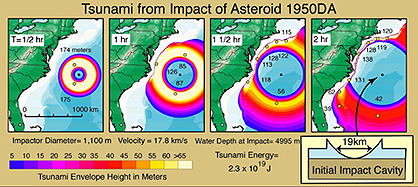
Collision Earth: The Threat From Outer Space, by Jason Jeffrey
Gamma Ray Bursts

happen frequently but so far away that they reach Earth very attenuated, and are surveiled by space probes (real-time GRB sky map). The first project, monitoring Soviet weapons, was named "Vela", from the Spanish for watchman, maybe in allusion to the BCE +-12,000 supernova observable from Earth.
Supervolcanos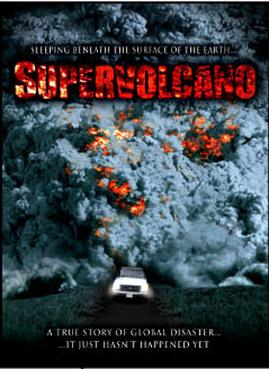 Major explosive caldera eruptions could recidivate at known hotspots, as Indonesia (with a Megatsunami) or at Yellowstone
Major explosive caldera eruptions could recidivate at known hotspots, as Indonesia (with a Megatsunami) or at Yellowstone
Supervolcano docudrama, BBC

Megatsunamis
Could be provoked by impact, earthquake, volcanic eruption, or megaslides as from Cumbre Vieja, Canarys, Atlantic, collapse & tsunami risk, 50 m at 7 km/h
Mega-tsunami: Wave of Destruction, BBC
or from a glacial lake outburst flood (GLOF)
Climate shift Global warming, ice cap melting, sea rise and typhoons/hurricanes, food and ecosystems disruption, ...
Global warming, ice cap melting, sea rise and typhoons/hurricanes, food and ecosystems disruption, ... Methane chlatrate hydrates catastrophic release from warming waters and melting permafrost.
Methane chlatrate hydrates catastrophic release from warming waters and melting permafrost.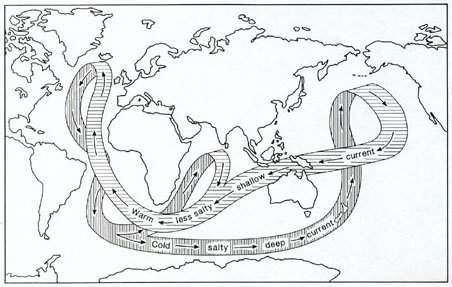
Atlantic ocean thermohaline conveyor belt (Gulf Stream system) dissolution.
Nuclear From widespread contamination by civilian pollution (leaks) or by military (Dr Strangelove) or depleted uranium atom bombs dispersion (ongoing but not of Extinction Level).
From widespread contamination by civilian pollution (leaks) or by military (Dr Strangelove) or depleted uranium atom bombs dispersion (ongoing but not of Extinction Level).
Epidemics Globalization, new transmissible viruses as influenza H5N1s and SARS. Biological warfare, where even extinct illnesses as Smallpox are kept as weapons (Outbreak). Lower-key risk from antibiotics resistance and economic decline (post-Soviet Russia). Genetically-modified transmissible sterility or resistance. Nanotechnology epidemic. Usual epidemics of tobaccomania, ethylomania, malnutrition or diet disorder, car accidents, wars and other violent deaths ...
Globalization, new transmissible viruses as influenza H5N1s and SARS. Biological warfare, where even extinct illnesses as Smallpox are kept as weapons (Outbreak). Lower-key risk from antibiotics resistance and economic decline (post-Soviet Russia). Genetically-modified transmissible sterility or resistance. Nanotechnology epidemic. Usual epidemics of tobaccomania, ethylomania, malnutrition or diet disorder, car accidents, wars and other violent deaths ...
Stupidity epidemic ...
Disclaimer: this is a bona fide review from online available information; if you plan to invest on this for the next catastrophy, as a trader (with a 10,000 years civilization-cycle horizon) or as an investor (for 5 million years at least to differenciate some valuable species), DYODD.



